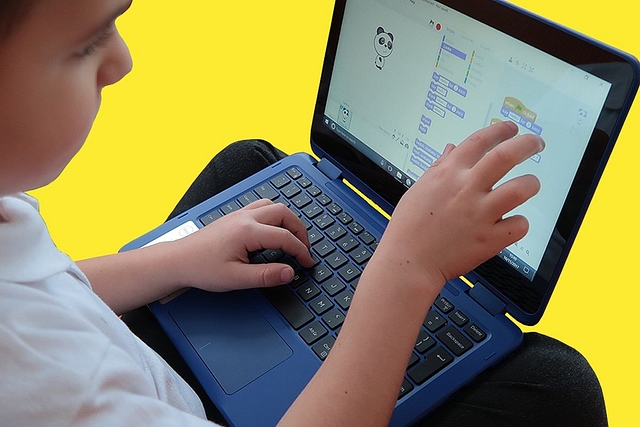
The Real Ekalavya Lesson: Mere Online Learning In Isolation Isn’t Good Enough
Online learning alone is not enough; you need classroom learning too to give your knowledge added value when it is used in a social environment.
Online learning has taken off like a rocket post-Covid-19, thanks to the closure of schools and educational institutions. However, we will learn its limitations soon enough.
Let me be clear. I am a huge fan of online learning as an education accelerator and enhancer. Online learning is great when it comes to doing short-term courses where specific skills are taught as part of a larger project to enhance the overall value of a human resource. But it is not a substitute for classroom learning, group learning, and teacher-enabled learning.
We all tend to draw the wrong conclusions from the story of Ekalavya, who makes a cameo appearance in the Mahabharata as Guru Dronacharya’s virtual shishya who is denied group learning prospects along with Arjuna and the rest of the Pandavas and Kauravas. When Guru Drona finds Ekalayva secretly practising in the forest to shoot arrows, and notes his innate skills, he demands his thumb as gurudakshina since Ekalavya was apparently using the guru’s image as his inspiration.
The story leads us to focus on the mean-mindedness of the guru and the devotion to dharma of his virtual shishya, which is fine, but we miss the larger, under-emphasised, point here: no matter what, it is highly unlikely that Ekalavya would have become as great an archer as Arjuna or Karna, both of whom had real gurus. Dronacharya in the former case, and Parashurama in the latter.
What Ekalavya was doing was practice in isolation, the ancient equivalent of today’s online courses, where the teacher is virtual, and the learning less real. Practice improves skills, but does not do much more. You can master facts and figures and learn concepts from online courses, but there is still something missing.
There are two points worth making: school is not only about the classroom, but early socialisation of the student. It is part of growing up to be human. It is not only about the teacher imparting knowledge to the student, but students learning from one another, and from specific situations they are put in.
Even at the other end of the learning spectrum, let’s say the IITs and IIMs, it is not the classroom that makes the difference here. If the classroom was all there was to it, we should be able to put all IIT/IIM lectures online and we would get great engineers and managers at a fraction of the cost. Why waste thousands of crores putting up expensive campuses and hostels?
What really happens at the IITs and IIMs is this: first, the entry norms are so tough that only the best and brightest get in. This means we get people pre-programmed to succeed. Second, when we put the best and the brightest in the same cauldron of mutual learning, the classroom teaching is probably a marginal input in their skill matrix. The students live and work with their equals in IQ and skills; they do projects together, and they compete with one another. Thus, even if the average IIM professor is of average quality – they produce little evidence of world-beating research – the IIM passouts are winners.
Coming back to the normal school classroom, where there are no real entry barriers to the intake of average students, we need to understand another thing: all children do not all learn the same way, which is what online learning forces them to do. This implies that many, many million children will not be as good as they could be by merely putting them through online learning.
Management consultant Peter Drucker wrote a brilliant book, Managing Oneself, where he talks about how to become better at what you do. The key to learning is to understand how you learn.
He writes: “You need to know your strengths, methods, and values. Learn your strengths through feedback analysis: writing down your plans and expectations, and revisiting these a year later. The results will surprise you. Improve your strengths, and seek help with your weaknesses. Find out how you work: do you learn through reading, listening, writing, or talking? Do you work in large or small groups? As a decision-maker or an adviser? Don’t try to change your methods; seek environments which suit them. (Italics mine)
Some children learn by listening attentively in class, others take copious notes and learn from writing and reading these notes later. Yet others, including those with attention deficit disorders, learn by doing things with classmates, and so on. Online learning may benefit only some of these learners.
This is what a classroom does – it enables you to find out your best way of learning, sometimes helped by your teacher, and at other times by your peers. The real deficit in today’s classroom is the quality of teachers, but even a bad teacher is better than no teacher at all.
It’s the same with doing work from home (WFH) versus going to the factory or office. You may well be more productive if there are no lunch-breaks and water cooler gossip sessions, but the point of the workplace isn’t only production efficiency. It is about growing and learning things from people that working alone will not teach you.
The binary between classroom learning and online learning is a false one. We need both. Online learning alone is not enough; you need classroom learning too to give your knowledge added value when it is used in a social environment. Humans are social beings first and foremost. I can bet that when the Covid-19 scare ends, most parents and students will learn the difference.